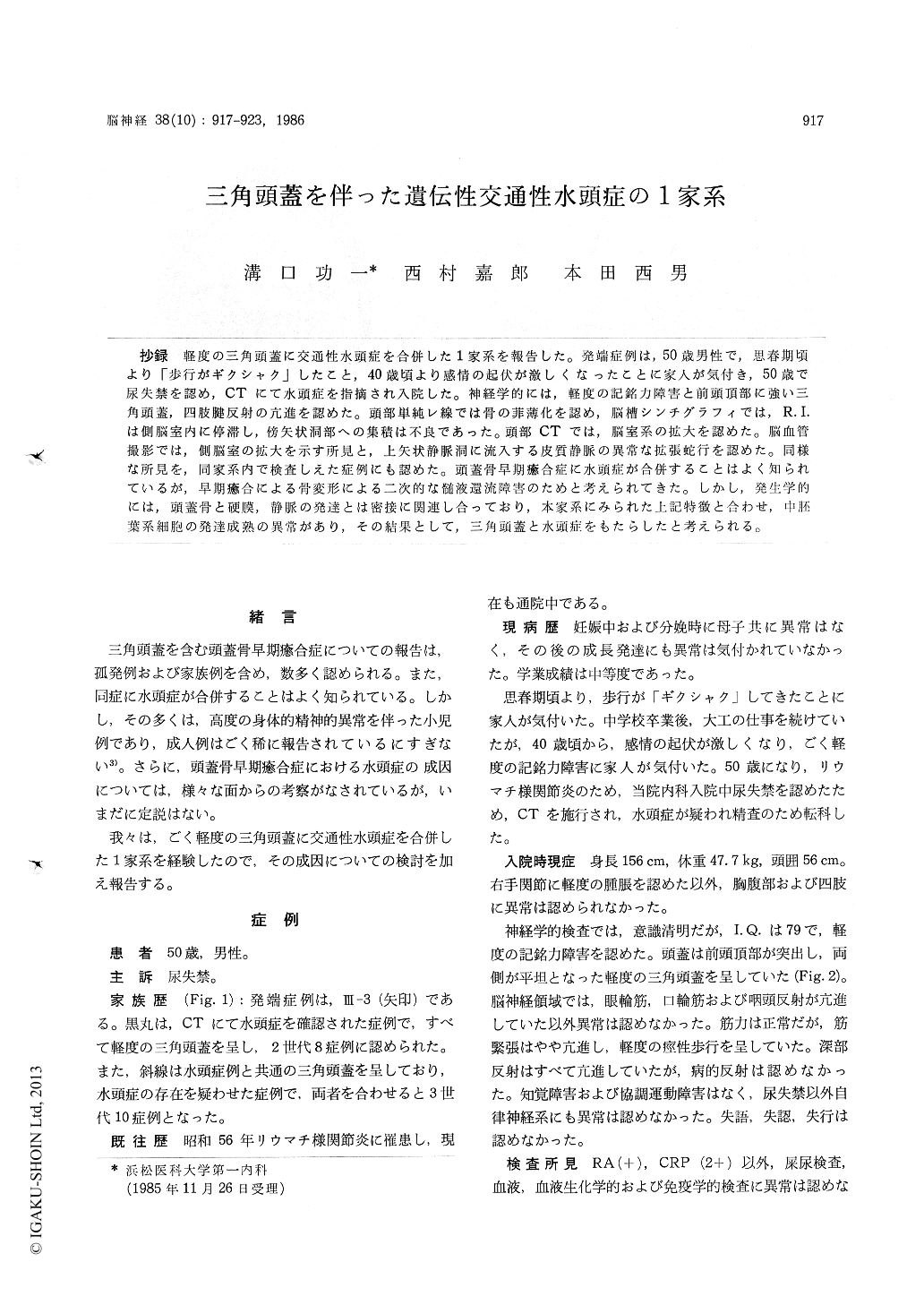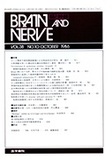Japanese
English
- 有料閲覧
- Abstract 文献概要
- 1ページ目 Look Inside
抄録 軽度の三角頭蓋に交通性水頭症を合併した1家系を報告した。発端症例は,50歳男性で,思春期頃より「歩行がギクシャク」したこと,40歳頃より感情の起伏が激しくなったことに家人が気付き,50歳で尿失禁を認め,CTにて水頭症を指摘され入院した。神経学的には,軽度の記銘力障害と前頭頂部に強い三角頭蓋,四肢腱反射の亢進を認めた。頭部単純レ線では骨の菲薄化を認め,脳槽シンチグラフィでは,R.I.は側脳室内に停滞し,傍矢状洞部への集積は不良であった。頭部CTでは,脳室系の拡大を認めた。脳血管撮影では,側脳室の拡大を示す所見と,上矢状静脈洞に流入する皮質静脈の異常な拡張蛇行を認めた。同様な所見を,同家系内で検査しえた症例にも認めた。頭蓋骨早期癒合症に水頭症が合併することはよく知られているが,早期癒合による骨変形による二次的な髄液還流障害のためと考えられてきた。しかし,発生学的には,頭蓋骨と硬膜,静脈の発達とは密接に関連し合っており,本家系にみられた上記特徴と合わせ,中胚葉系細胞の発達成熟の異常があり,その結果として,三角頭蓋と水頭症をもたらしたと考えられる。
We studied a family of hereditary hydrocepha-lus with trigonocephaly, affecting eight members (four males and four females) across two genera-tions. A proband in this family was 51 yesrs old man, who complained of nonprogressive gait dis-turbance afetr the age of 20 years. He was admit-ted to our hospital because of non-neurological dis-ease. Accidentally urinary incontinence appeared and then CT scan was performed, which revealed marked dilatation of the lateral ventricles. He was short stature and showed trigonocephalic fore-head, but his head circumference was 56 cm. Mild dementia, spastic gait and hyperreflexia were observed on neurological examinations. A lumbar puncture disclosed that cerebrospinal fluid pressure was 115 mm H2O and sugar, protein and cells were normal. His skull X-ray film demonstrated tem-poral buldging of the calvarium, but its breadth, length and height were within normal limits. Sagittal, coronal and lomboid sutures were not fused. However, skull bones were thinned and the top of dorsum sellae was erosive. A marked symmetrical dilatation of lateral, third and fourth ventricles were found on CT scan, to the cont-rary, bilateral Sylvian fissures and cortical sulci were slightly widened. On R. I. cisternography, ventricular reflux was noted during 3 to 72 hours after the injecton. No accumulation of R. I. was observed in the parasagittal region. In the arteri-al phase of right carotid angiography, slight dis-placement was noted in Sylvian branches of bi-lateral middle cerebral arteries. Cortical segments were less undulated. Bilateral anterior cerebral arteries were rounded and slight elevation of both pericallosal arteries was found. Bilateral internal cerebral veins were flattened and venous angle was slightly widened in the venous phase. A few cor-tical veins were widened and tortuous near the superior sagittal sinus, where contrast media were remained uncleared even after the late venous phase.
Charateristic features of eight affected members were :
1. All showed communicating hydrocephalus and trigonocephaly regardless of sexes. The tri-gonocephalic features were more prominent in males than in females.
2. Spastic gait was the initial symptom, starting during third decades. In the fifth decades, they showed dementia. But their symptoms were mini-mal, so they lived without consulting physicians.
3. R. I. cisternography, performed on four mem-bers in this family, revealed disturbed cerebro-spinal fluid absorption in the superior sagittal sinus. On the carotid angiography, performed on three members, both signs of bilateral ventricular dila-tation and abnormalities of cortical veins the super-ior sagittal sinus were found. These findings suggested that abnormalities of cortical veins near the superior sagittal sinus could induce disturbance of cerebrospinal fluid absorption, leading to hydro-cephalus.
4. Any anomalies, suggesting metabolic disor-ders, were not observed in these members. Cases of communicating hydrocephalus with cra-niosynostosis have been reported previously. In these reports, these anomalies were accompanied by other severe deformities either of the body or the skull. And the hydrocephalus was considered to be induced by the disturbance of cerebrospinal fluid path due to deformed skull. But in this fa-mily, we suggest that their communicating hydro-cephalus were due to the disturbance of cerebro-spinal absorption in the superior sagittal sinus. Because the development of dural sinus and corti-cal veins are closely related to the development of the skull bones, particularly adjacent to the dural sinus. Thus, we propose both trigonocephaly and venous abnormalities are genetically determined developmental errors, resulting in communicating hydrocephalus.

Copyright © 1986, Igaku-Shoin Ltd. All rights reserved.


